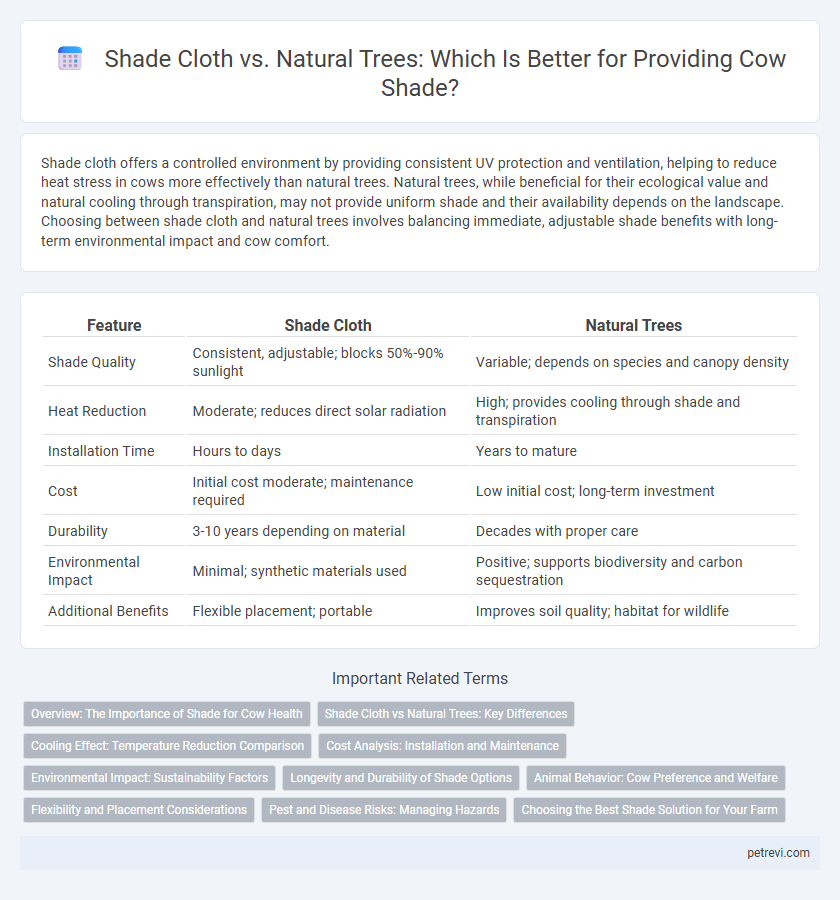Shade cloth offers a controlled environment by providing consistent UV protection and ventilation, helping to reduce heat stress in cows more effectively than natural trees. Natural trees, while beneficial for their ecological value and natural cooling through transpiration, may not provide uniform shade and their availability depends on the landscape. Choosing between shade cloth and natural trees involves balancing immediate, adjustable shade benefits with long-term environmental impact and cow comfort.
Table of Comparison
| Feature | Shade Cloth | Natural Trees |
|---|---|---|
| Shade Quality | Consistent, adjustable; blocks 50%-90% sunlight | Variable; depends on species and canopy density |
| Heat Reduction | Moderate; reduces direct solar radiation | High; provides cooling through shade and transpiration |
| Installation Time | Hours to days | Years to mature |
| Cost | Initial cost moderate; maintenance required | Low initial cost; long-term investment |
| Durability | 3-10 years depending on material | Decades with proper care |
| Environmental Impact | Minimal; synthetic materials used | Positive; supports biodiversity and carbon sequestration |
| Additional Benefits | Flexible placement; portable | Improves soil quality; habitat for wildlife |
Overview: The Importance of Shade for Cow Health
Providing adequate shade is crucial for maintaining cow health, as it helps regulate body temperature and reduces heat stress, which can negatively impact milk production and overall well-being. Shade cloth offers a controlled, adjustable solution that blocks a significant percentage of UV rays and heat, while natural trees provide additional benefits such as oxygen release, windbreak, and a habitat for wildlife. Effective shade solutions improve feed intake and hydration rates, ensuring better growth and productivity in dairy and beef cattle.
Shade Cloth vs Natural Trees: Key Differences
Shade cloth provides consistent, adjustable protection from sunlight and heat, enhancing cow comfort by reducing heat stress more predictably than natural trees. Natural trees offer ecological benefits such as oxygen production and habitat creation, but their shade varies with tree density, species, and seasonal leaf cover, which can result in uneven cooling. Shade cloth typically requires less maintenance and offers flexibility in placement, whereas trees require long-term growth and management but contribute to soil health and biodiversity.
Cooling Effect: Temperature Reduction Comparison
Shade cloth can reduce temperature beneath it by up to 15degF, offering immediate cooling for cows in hot environments. Natural trees provide a more consistent and varied cooling effect through evapotranspiration, often lowering temperatures by 10degF to 20degF depending on tree species and density. Combining shade cloth with natural trees optimizes thermal comfort, improving cow welfare and productivity during heat stress periods.
Cost Analysis: Installation and Maintenance
Shade cloth installation for cow shade offers a lower upfront cost compared to planting natural trees, with expenses generally ranging from $1 to $3 per square foot depending on material quality. Maintenance costs for shade cloth include periodic inspections, repairs, and eventual replacement every 5-10 years, whereas natural trees require ongoing watering, pruning, and pest management, often incurring higher labor and resource expenses over time. The choice between shade cloth and natural trees should consider not only initial installation costs but also long-term financial implications related to durability and ecosystem benefits for cattle comfort.
Environmental Impact: Sustainability Factors
Shade cloth offers a lightweight, reusable solution with minimal water usage and reduced land disturbance compared to planting natural trees. Natural trees provide habitat biodiversity, carbon sequestration, and enhance soil health, but require longer growth periods and ongoing maintenance. Balancing immediate environmental impact and long-term ecosystem benefits is essential for sustainable cow shade solutions.
Longevity and Durability of Shade Options
Shade cloth offers reliable UV protection for cows but often requires replacement every 3 to 5 years due to material degradation from weather exposure. Natural trees provide long-lasting shade lasting decades with minimal maintenance while improving air quality and soil health in pasturelands. Durability of shade cloth is limited by environmental wear, whereas trees offer sustainable, renewable shade with ecological benefits.
Animal Behavior: Cow Preference and Welfare
Cows exhibit a clear preference for natural tree shade over shade cloth due to the cooler microclimate and natural airflow provided by trees, promoting better thermoregulation and reducing heat stress. Natural trees also offer varied shade patterns and shelter from wind, enhancing cow comfort and encouraging natural behaviors such as grazing and resting. Research indicates that improved welfare under natural shade results in increased feed intake and milk production, supporting overall herd productivity.
Flexibility and Placement Considerations
Shade cloth offers flexible installation options around cattle pens, allowing precise control over sun exposure and easy adjustment to seasonal changes. Natural trees provide permanent shade and contribute to the environment with air purification and habitat support but require ample space and time for growth. Placement of shade cloth is ideal for temporary or movable shelter needs, while trees suit long-term, sustainable shade solutions in pasture areas.
Pest and Disease Risks: Managing Hazards
Shade cloth offers controlled pest and disease management for cow shade by limiting exposure to harmful insects and airborne pathogens. Natural trees provide organic shade but may harbor pests such as ticks, flies, and mites, increasing risk of infestations and disease transmission among cattle. Integrating pest control measures and monitoring is essential to reduce hazards in both shade environments and maintain animal health.
Choosing the Best Shade Solution for Your Farm
Selecting the ideal shade solution for cows depends on factors like cost, cooling efficiency, and maintenance. Shade cloth provides instant relief from heat and is cost-effective with minimal upkeep, while natural trees offer long-term cooling benefits, improved air quality, and soil stability but require years to mature. Evaluating your farm's budget, timeline, and environmental goals helps determine whether shade cloth or natural tree planting best supports cow health and productivity.
Shade Cloth vs Natural Trees for Cow Shade Infographic

 petrevi.com
petrevi.com